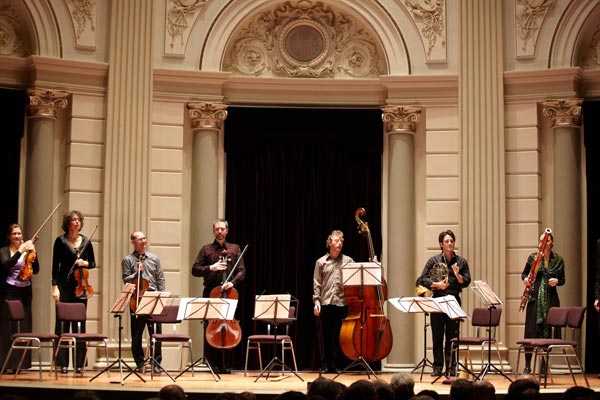Journal entries
Le Bon Journal
About
Search
Contact
Readers write
Show your support
Anne Ku writes about her travels, conversations, thoughts, events, music, and anything else that is interesting enough to fill a web page. She has written and produced two chamber operas, premiered in Utrecht, Netherlands. See her publication list for more.
Support the Bon Journal by keeping analyticalQ.com alive and free. Find out about Sponsorship or how else you can show your support
Bon Journal
Camenae Collective Octet in Amsterdam
I invited my Dutch friend, who had just returned from York in England, to a concert entitled "A Musical chain -- inspired by Schubert" which was scheduled for several locations: Utrecht, Assen, Amsterdam, Velp and Hengstdijk. The only name that I knew on the programme was Schubert. I didn't know the Camenae Collective or its musicians or the other two composers Roderik de Man and Sofia Gubaidulina.
I did know the Concertgebouw and Schubert. That was all that was familiar to me.
And that was enough to make an evening date with my friend on Wednesday 16th December in Amsterdam.
Familiarity breeds comfort. Perhaps that's why Schubert's Octet in F was placed last on the programme, after the intermission. Unlike the traditional way of programming the music in chronological order, the Camenae Collective began with a world premiere of "Time present/past" by Amsterdam-based composer Roderik de Man (b. 1941). I recognised his wife Annelie de Man, the harpsichordist, who sat next to him in 6th row.

Camenae Octet photo credit: Hans Hijmering, Concertgebouw Amsterdam 16 Dec 2009
As with most new music, I need to hear it more than once to remember it. "Stickiness" is never the intention of new music, and new music rarely "sticks." If all else fails, I could at least look forward to Schubert. I was secretly relieved that Schubert was scheduled last. I knew and trusted his music.
What linked the three pieces in "A Musical chain -- inspired by Schubert"?
Roderik de Man used texts of the poet T.S. Eliot. This is the link to the next piece by Sofia Gubaidulina --- "Hommage to T.S. Eliot."
The same octet, led by violinist Tiziana Pintus, played all three works. It was this octet, comprising of two violins, a viola, cello, double bass, French horn, bassoon, and clarinet, that Gubaidulina used as a starting point for her piece. It was this octet -- Schubert's Octet in F -- that ended the programme.
Without reading the programme notes or the press release, I wouldn't have guessed the connection between the three works. Schubert came before T.S. Eliot. Gubaidulina was born in another period and region of the world. Roderik de Man was sitting a row behind me. They could not have met and exchanged ideas. Yet here we were, sitting in the Klein Zaal (the small hall) of the famous Concertgebouw watching a serious performance by an octet.
An American friend living in Amsterdam had told me that the Kleine Zaal is where the serious aficionados of "art music" convene. The Grote Zaal, she had said, was for tourists and others to see and be seen. On this week night, the small hall was far from full. On the other hand, the big hall was completely empty. We were among the serious listeners.
The members of the octet walked on stage with their pre-tuned instruments in hand. What emerged was a modern sound, one that's distinctly contemporary and required a kind of reception that's not an embrace of the familiar but a willingness to experience the unfamiliar. Roderik de Man's "Time present/past" was a Camenae commission, inspired by Eliot's poem Burnt Norton, the first of Four Quartets he wrote over a period of 8 years.
Time present and time past
Are both perhaps present in time future,
and time future conatined in the past. (more)
The French horn stood out from the rest, and indeed was specifically acknowledged by the composer at the end of the premiere. During the intermission, I approached the young horn player Okke Westdorp to ask if it was a difficult piece. I was introduced to the French horn in 2007 when I attended a performance of Brahm's trio for violin, horn, and piano. It's a beautiful instrument that fills the gap between the strings and the winds, surprisingly flexible and dynamically diverse.

Claron McFadden with Camenae Octet photo credit: Hans Hijmering, Concertgebouw Amsterdam 16-12-2009
Sofia Gubaidulina composed "Hommage to T.S. Eliot" in 1987 for the Latvian violinist and conductor Gidon Kremer and his ensemble to fill in a programme with Schubert's Octet. The piece began with the string quintet, then the French horn, bassoon, and clarinet as if in a separate (not overlapping) ensemble. The soprano Claron McFadden took the cue from the ending note and began her solo acapella. From Eliot's Four Quartets (1935-1942), she sang: Time and the bell have buried the day,.....
The strange leaps, unusual intervals of modern music, are surely the greatest challenge to a soloist. Where does she get her reference from? After navigating blindly (i.e. without accompaniment), how does she land on the right note (i.e. when the ensemble begins again)?
It's a mystery to me, for a pianist never has to worry about staying in tune during a performance (unless the piano is totally unreliable). On the other hand, the solo singer has to stay in tune, resisting the tendency to sing flat. The ensemble instruments, even if tuned at the beginning, must be played in tune --- which the musicians did remarkably well. Unlike pianists who cannot and need not adjust their instruments while playing, string, brass, and wind players have to listen and play in tune the entire time. That, I would say, is the main difference between a high-calibre ensemble such as the Carmenae Collective and one of less experience.
After the intermission, we returned to the Kleine Zaal for the final hour of Schubert. The Octet in F (1824) comprises of six movements:
1. Adagio – Allegro – Più allegro ;
2. Adagio ;
3. Allegro vivace – Trio – Allegro vivace ;
4. Andante – variations. Un poco più mosso – Più lento ;
5. Menuetto. Allegretto – Trio – Menuetto – Coda ;
6. Andante molto – Allegro – Andante molto – Allegro molto
It was refreshing to hear the familiar theme of Schubert's "The Wanderer" in the first movement and the predictable sound from the classic era. It's the same feeling of coming home after being with the unfamiliar for awhile. I was even more pleased to find out that the entire score and transcriptions are available for free online. Perhaps one day, all scores will be available online --- for us to examine after the music has died.
For now, this was an intellectual evening --- a programme of music chosen for an octet, echoing the words of TS Eliot about time.
